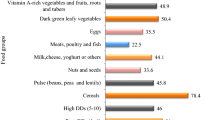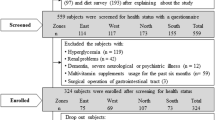Abstract
Women in low-income settings, common in India, are at risk of inadequate zinc intake due to poor diet quality and low consumption of flesh foods rich in zinc. The aims of this study were to assess the prevalence of zinc status of non-pregnant rural and tribal women living in central India and to identify dietary and non-dietary factors associated with the biochemical zinc status of these women. Rural and tribal non-pregnant women 18–30 years of age were selected using proportion to population sampling near Nagpur, Maharashtra, India. Sociodemographic, biochemical (serum zinc), clinical, and dietary data (1-day interactive 24-h recall) were collected. The mean age of women (n = 109; rural = 52; tribal = 56) was 23.2 years and mean BMI was 17.9 kg/m2. The majority of the participants identified as being non-vegetarian (72 %). The mean ± SD serum zinc concentration was 10.8 ± 1.6 μmol/L, and 52 % of participants had a low serum zinc concentration according to the International Zinc Nutrition Consultative Group (IZiNCG). The median (first and third quartile) energy, zinc intake, and phytate/zinc molar ratio was 5.4 (4.2, 6.7) MJ/day, 5.3 (3.8, 7.0) mg/day, and 26 (22, 28), respectively. Zinc intakes were well below IZiNCG recommendations for dietary zinc of 9 mg/day for non-pregnant women aged 14–18 years and 7 mg/day for non-pregnant women aged ≥19 years. Using linear regression analysis to identify non-dietary and dietary factors associated with serum zinc, a significant association was only found for current lactation (p = 0.012) and energy intake (p < 0.001). Diets low in energy with poor bioavailability of dietary zinc are likely to be the primary cause of the high proportion of Indian women with zinc deficiency.
Similar content being viewed by others
References
Hotz C, Brown KH (2004) International Zinc Nutrition Consultative Group (IZiNCG) technical document #1: assessment of the risk of zinc deficiency in populations and options for its control. Food Nutr Bull 25:S94–S203
Gibson R (2006) The Rank Prize Lecture: zinc: the missing link in combating micronutrient malnutrition in developing countries. Proc Nutr Soc 65:51–60
Torheim L, Ferguson E, Penrose K, Arimond M (2010) Women in resource-poor settings are at risk of inadequate intakes of multiple micronutrients. J Nutr 140:S2051–2058S
McWilliams M, Heller H (2003) Food around the world. Prentice Hall, New York
Aktar S (2013) Zinc status in South Asian populations—an update. J Health Popul Nutr 31:139–149
National Nutrition Monitoring Bureau (2000) Diet and nutritional status of tribal population: report on first repeat survey. Technical report 19. National Institute of India, Hyderabad
National Nutrition Monitoring Bureau (2002) Diet and nutritional status of rural population. Technical report no 21. National Institute of India, Hyderabad
National Nutrition Monitoring Bureau (2006) Diet and nutritional status of population and prevalence of hypertension among adults in rural areas. Technical report no 24. National Institute of India, Hyderabad
National Nutrition Monitoring Bureau (2009) Diet and nutritional status of tribal population and prevalence of hypertension among adults: report on second repeat survey. Technical report no 25. National Institute of India, Hyderabad
Vijayaraghavan K, Balakrishna N, Antony G (2000) Special report—report on food and nutrient intakes of individuals. National Nutrition Monitoring Bureau technical report no 20. National Institute of India, Hyderabad
Pathak P, Kapil U, Kumar Kapoor S, Nand Dwivedi S, Singh R (2003) Magnitude of zinc deficiency among nulliparous nonpregnant women in a rural community of Haryana State, India. Food Nutr Bull 24:368–371
Agte V, Chiplonkar S, Tarwadi K (2005) Factors influencing zinc status of apparently healthy Indians. J Am Coll Nutr 24:334–341
Gopalan C, Rama Sastri B, Balasubramanian S (2004) Nutritive value of Indian foods. Revised and updated by Narasinga RB, Deosthale YG & Pant KC. National Institute of India, Hyderabad, India.
Menon K, Skeaff S, Thomson C, Gray A, Ferguson E, Zodpey S et al (2011) Concurrent micronutrient deficiencies are prevalent in nonpregnant rural and tribal women from central India. Nutrition 27:496–502
Gibson R, Ferguson E (2008) An interactive 24 hour recall for assessing the adequacy of iron and zinc intakes in developing countries. HarvestPlus Technical Monograph 8. International Life Sciences Institute, Washington DC
Siong T, Noor M, Azudin M, Idris K (eds) (1997) Nutrient composition of Malaysian foods. Malaysian Food Composition database programme. Institute of Medicine, Kuala Lumpur
Food and Agriculture Organisation of the United Nations (FAO) (1984) International Network of Food Data Systems (INFOODS): FAO, Rome, Italy
Food Standards Agency (2002) McCance and Widdowson’s the composition of foods, 6th edn. Royal Society of Chemistry, Cambridge
Swaminathan N, Kantha J, Narayana R, Chandiramani S, Subramanyam L, Indira K (1981) Balanced diets and nutritive value of common recipes. Central Food Technological Research Institute Press, Mysore
United States Department of Agriculture (USDA) Agricultural Research Service (2008) USDA national nutrient database for standard reference, Release 21. Beltsville, MD, USA
Tan S, Wenlock R, Buss D (1985) Immigrant foods, second supplement to McCance and Widdowson’s the composition of foods (4th edition). HM Stationery Office, London, UK
Holland B, Unwin I, Buss D (1988) Cereals and cereal products, third supplement to McCance and Widdowson’s the composition of foods, 4th edn. The Royal Society of Chemistry and the Ministry of Agriculture, Fisheries and Food, Nottingham
Holland B, Brown J, Buss D (1993) Fish and fish products, third supplement to McCance and Widdowson’s the composition of foods, 5th edn. The Royal Society of Chemistry and the Ministry of Agriculture, Fisheries and Food, Cambridge
Bunch S, Murphy S (1997) User’s guide to the operation of the World Food Dietary Assessment System version 2.0 Office of Technology Licensing. University of California, Berkeley
Athar N, McLaughlin J, Taylor G, Mishra S (2006) The concise New Zealand food composition tables. Institute for Crop and Food Research Limited, Crown Research Institute and Ministry of Health, Wellington, New Zealand
United States Department of Agriculture (USDA) (2007) USDA table of nutrient retention factors: release 6. United States Department of Agriculture, Beltsville
Hess S, Peerson J, King J, Brown K (2007) Use of serum zinc concentration as an indicator of population zinc status. Food Nutr Bull 28:S403–S429
World Health Organisation (WHO) Expert Consultation (2004) Appropriate body-mass index for Asian populations and its implications for policy and intervention strategies. Lancet 363:157–163
Shetty P, James W (1994) Body mass index—a measure of chronic energy deficiency in adults. Food and Nutrition Paper 56. FAO (Food and Agriculture Organisation of the United Nations), Rome
Gibson R (2006) Principles of nutritional assessment, 2nd edn. Oxford University Press, New York
National Research Council (2006) Dietary reference intakes: the essential guide to nutrient requirements. The National Academies Press, Washington, D.C
Hotz C (2007) Dietary indicators for assessing the adequacy of population zinc intakes. Food Nutr Bull 28:430S–453S
IZiNCG (International Zinc Nutrition Collaborative Group) (2007) Determining the risk of zinc deficiency: assessment of dietary zinc intake. IZiNCG Technical Brief No. 03
Kapil U, Singh P, Pathak P (2003) Serum zinc levels amongst tribal population in a district of Jharkhand State, India: a pilot study. East J Med 8:33–34
New Zealand: Ministry of Health (MOH) and Australian Government: Department of Health and Ageing and National Health and Medical Research Council (NHMRC) (2006) Nutrient reference values for Australia and New Zealand. Canberra, Australia
Lönnerdal B (2000) Dietary factors influencing zinc absorption. J Nutr 130:1378S–1383S
Gibson R (1994) Zinc nutrition in developing countries. Nutr Res Rev 7:151–173
Gibson R, Perlas L, Hotz C (2006) Improving the bioavailability of nutrients in plant foods at the household level. Proc Nutr Soc 65:160–68
Reddy P, Rao A (2000) Dietary habits, food consumption and nutrient intake among the Sugali, a tribal population of Andhra Pradesh, India. Asia Pac J Clin Nutr 9:12–17
Mittal P, Srivastava S (2006) Diet, nutritional status and food related traditions of Oraon tribes of New Mal (West Bengal), India. Rural Remote Health 6:385–393
O’Neil CE, Keast DR, Fulgoni VL, Nicklas TA (2012) Food sources of energy and nutrients among adults in the US: NHANES 2003–2006. Nutrients 4:2097–120
Abebe Y, Bogale A, Hambidge K, Stoecker B, Arbide I, Teshome A et al (2008) Inadequate intakes of dietary zinc among pregnant women from subsistence households in Sidama, Southern Ethiopia. Public Health Nutr 11:379–386
Chandyo R, Strand T, Mathisen M, Ulak M, Adhikari R, Bolann B et al (2009) Zinc deficiency is common among healthy women of reproductive age in Bhaktapur, Nepal. J Nutr 139:594–597
Hotz C, Peerson J, Brown K (2003) Suggested lower cutoffs of serum zinc concentrations for assessing zinc status: reanalysis of the second National Health and Nutrition Examination Survey data (1976–1980). Am J Clin Nutr 78:756–764
Alloway B (2008) Zinc in soils and crop nutrition. International Zinc Association and International Fertilizer Association, Brussels
Chiplonkar S, Agte V (2007) Extent of error in estimating nutrient intakes from food tables versus laboratory estimates of cooked foods. Asia Pac J Clin Nutr 16:227–239
Acknowledgments
This study was supported by a University of Otago Research Grant and the Department of Human Nutrition’s Performance Based Research Fund. We thank all the women and families who participated in this study; our dedicated research assistants Dr. Harish Wankhede, Jayasree Barai, Mamta Wankhede, Ritu Hadekar, Neelima Selukar, Vaishali Nagarare, Vaishali Patil, Sachin Paunikar, Raju Kalbhut, Vijay Panchdane, Rupali Nimbekar, and Atul Dandekar; Ramtek Block Primary Health Centre medical officers and staff; and Ramtek Block ICDS staff.
Author information
Authors and Affiliations
Corresponding author
Rights and permissions
About this article
Cite this article
Herbst, C.A., Menon, K.C., Ferguson, E.L. et al. Dietary and Non-dietary Factors Associated with Serum Zinc in Indian Women. Biol Trace Elem Res 161, 38–47 (2014). https://doi.org/10.1007/s12011-014-0090-9
Received:
Accepted:
Published:
Issue Date:
DOI: https://doi.org/10.1007/s12011-014-0090-9




